Nitrate Concentration in Leachate—Essential Information for Reducing Nitrogen Surplus and Groundwater Pollution from Agricultural Land in Slovakia
Abstract
:1. Introduction
2. Materials and Methods
2.1. Delineation of the Evaluated Area
2.2. Calculation of Nitrogen Balance and Nitrates Concentration in Leachate
3. Results
4. Discussion
5. Conclusions
Author Contributions
Funding
Institutional Review Board Statement
Informed Consent Statement
Data Availability Statement
Conflicts of Interest
References
- Andjelov, M.; Kunkel, R.; Uhan, J.; Wendland, F. Determination of nitrogen reduction levels necessary to reach groundwater quality targets in Slovenia. J. Environ. Sci. 2014, 26, 1806–1817. [Google Scholar] [CrossRef] [PubMed]
- European Commission. Report from the Commission to the Council and the European Parliament on the Implementation of Council Directive 91/676/EEC Concerning the Protection of Waters Against Pollution Caused by Nitrates from Agricultural Sources Based on Member State Reports for the Period 2016–2019, COM(2021) 1000 Final; European Commission: Brussels, Belgium, 2021. [Google Scholar]
- European Environment Agency. European Waters. Assessment of Status and Pressures 2018; EEA Report No. 7/2018; European Environment Agency: Copenhagen, Denmark, 2018. [Google Scholar]
- European Environment Agency. Water and Agriculture: Towards Sustainable Solutions; EEA Report No. 17/2020; European Environment Agency: Copenhagen, Denmark, 2021. [Google Scholar]
- Musacchio, A.; Re, V.; Mas-Pla, J.; Sacchi, E. EU Nitrates Directive, from theory to practice: Environmental effectiveness and influence of regional governance on its performance. Ambio 2020, 49, 504–516. [Google Scholar] [CrossRef] [PubMed] [Green Version]
- Cibulka, R.; Rajczyková, E.; Bujnovský, R.; Májovská, A.; Ľuptáková, A.; Paľušová, Z.; Grófová, R.; Gergeľová, Z.; Halásová, M.; Píš, V.; et al. Report on the State of Implementation of Council Directive 91/676/EEC Concerning the Protection of Water against Pollution Caused by Nitrates from Agricultural Resources in the Slovak Republic; Ministry of Environment & Ministry of Agriculture and Rural Development: Bratislava, Slovakia, 2020. Available online: https://cdr.eionet.europa.eu/sk/eu/nid/ (accessed on 29 November 2021).
- Orellana-Macías, J.M.; Merchán, D.; Causapé, J. Evolution and assessment of a nitrate vulnerable zone over 20 years: Gallocanta groundwater body (Spain). Hydrogeol. J. 2020, 28, 2207–2221. [Google Scholar] [CrossRef]
- Van Grinsven, H.J.M.; Ten Berge, H.F.M.; Dalgaard, T.; Fraters, B.; Durand, P.; Hart, A.; Hofman, G.; Jacobsen, B.H.; Lalor, S.T.J.; Lesschen, J.P.; et al. Management, regulation and environmental impacts of nitrogen fertilization in northwestern Europe under the Nitrates Directive; a benchmark study. Biogeosciences 2012, 9, 5143–5160. [Google Scholar] [CrossRef] [Green Version]
- Ascott, M.J.; Gooddy, D.C.; Fenton, O.; Vero, O.; Ward, R.S.; Basu, N.B.; Worrall, F.; Van Meter, K.; Surridge, B.W.J. The need to integrate legacy nitrogen storage dynamics and time lags into policy and practice. Sci. Total Environ. 2021, 781, 146698. [Google Scholar] [CrossRef]
- Paradis, D.; Ballard, J.-M.; Lefebvre, R.; Savard, M.M. Multi-scale nitrate transport in a sandstone aquifer system under intensive agriculture. Hydrogeol. J. 2018, 26, 511–531. [Google Scholar] [CrossRef] [Green Version]
- Turkeltaub, T.; Jia, X.; Zhu, Y.; Shao, M.-A.; Binley, A. Recharge and nitrate transport through the deep vadose zone of the loess plateau: A regional-scale model investigation. Water Resour. Res. 2018, 54, 4332–4346. [Google Scholar] [CrossRef]
- Vero, S.W.; Basu, N.B.; Van Meter, K.; Richards, K.G.; Mellander, P.E.; Healy, M.G.; Fenton, O. Review: The environmental status and implications of the nitrate time lag in Europe and North America. Hydrogeol. J. 2018, 26, 7–22. [Google Scholar] [CrossRef]
- Wang, L.; Stuart, M.E.; Lewis, M.A.; Ward, R.S.; Skirvin, D.; Naden, P.S.; Collins, A.L.; Ascott, M.J. The changing trend in nitrate concentrations in major aquifers due to historical nitrate loading from agricultural land across England and Wales from 1925 to 2150. Sci. Total Environ. 2016, 542, 694–705. [Google Scholar] [CrossRef] [Green Version]
- Klages, S.; Heidecke, C.; Osterburg, B.; Bailey, J.; Calciu, I.; Casey, C.; Dalgaard, T.; Frick, H.; Glavan, M.; D’Haene, K.; et al. Nitrogen surplus—A unified indicator for water pollution in Europe? Water 2020, 12, 1197. [Google Scholar] [CrossRef] [Green Version]
- Kuhr, P.; Haider, J.; Kreins, P.; Kunkel, R.; Tetzlaff, B.; Vereecken, H.; Wendland, F. Model based assessment of nitrate pollution of water resources on a federal state level for the dimensioning of agro-environmental reduction strategies. The North Rhine-Westphalia (Germany) case study. Water Resour. Manag. 2013, 27, 885–909. [Google Scholar] [CrossRef]
- Sieling, K.; Kage, H. N balance as an indicator of N leaching in an oilseed rape—winter wheat—winter barley rotation. Agric. Ecosyst. Environ. 2006, 115, 261–269. [Google Scholar] [CrossRef]
- Bujnovský, R.; Malík, P.; Švasta, J. Evaluation of the risk of the diffuse pollution of groundwater by nitrogen substances from agricultural land use as background for allocation of effective measures. Ekológia 2016, 35, 66–77. [Google Scholar] [CrossRef] [Green Version]
- Capri, E.; Civita, M.; Corniello, A.; Cusimano, G.; De Maio, M.; Ducci, D.; Fait, G.; Fiorucci, A.; Hauser, S.; Pisciotta, A.; et al. Assessment of nitrate contamination risk: The Italian experience. J. Geochem. Explor. 2009, 102, 71–86. [Google Scholar] [CrossRef] [Green Version]
- McLellan, E.L.; Cassman, K.G.; Eagle, A.J.; Woodbury, P.B.; Sela, S.; Tonitto, C.; Marjerison, R.D.; Van Es, H.M. The nitrogen balancing act: Tracking the environmental performance of food production. BioScience 2018, 68, 194–203. [Google Scholar] [CrossRef]
- Mititelu-Ionuș, O.; Simulescu, D.; Popescu, S.M. Environmental assessment of agricultural activities and groundwater nitrate pollution susceptibility: A regional case study (Southwestern Romania). Environ. Monit. Assess. 2019, 191, 501. [Google Scholar] [CrossRef]
- Orellana-Macías, J.M.; Perles Roselló, M.J.; Cauasapé, J. A methodology for assessing groundwater pollution hazard by nitrates from agricultural sources: Application to the Gallocanta groundwater basin (Spain). Sustainability 2021, 13, 6321. [Google Scholar] [CrossRef]
- Ackermann, A.; Mahnkopf, J.; Heidecke, C.; Venohr, M. Reducing agricultural nitrogen inputs in the German Baltic Sea catchment—Trends and policy options. Water Sci. Technol. 2016, 74, 1060–1068. [Google Scholar] [CrossRef]
- Pärn, J.; Pinay, G.; Mander, Ü. Indicators of nutrients transport from agricultural catchments under temperate climate: A review. Ecol. Indic. 2012, 22, 4–15. [Google Scholar] [CrossRef]
- Velthof, G.L.; Oudendag, D.; Witzke, H.P.; Asman, W.A.H.; Klimont, Z.; Oenema, O. Integrated assessment of nitrogen loses from agriculture in EU-27 using MITERRA-EUROPE. J. Environ. Qual. 2009, 38, 402–417. [Google Scholar] [CrossRef]
- Velthof, G.L.; Lesschen, J.P.; Webb, J.; Pietrzak, S.; Miatkowski, Z.; Pinto, M.; Kros, J.; Oenema, O. The impact of the Nitrates Directive on nitrogen emissions from agriculture in the EU-27 during 2000–2008. Sci. Total Environ. 2014, 468–469, 1225–1233. [Google Scholar] [CrossRef] [PubMed]
- Hansen, B.; Thorling, L.; Schullehner, J.; Termansen, M.; Dalgaard, T. Groundwater nitrate response to sustainable nitrogen management. Sci. Rep. 2017, 7, 8566. [Google Scholar] [CrossRef] [PubMed]
- Hansen, B.; Sonnenborg, T.O.; Møller, I.; Bernth, J.D.; Høyer, A.-S.; Rasmussen, P.; Sandersen, P.B.E.; Jørgensen, F. Nitrate vulnerability assessment of aquifers. Environ. Earth Sci. 2016, 75, 999. [Google Scholar] [CrossRef] [Green Version]
- Bowles, T.M.; Atallah, S.S.; Campbell, E.E.; Gaudin, A.C.M.; Wieder, W.R.; Grandy, A.S. Addressing agricultural nitrogen loses in a changing climate. Nat. Sustain. 2018, 1, 399–408. [Google Scholar] [CrossRef]
- Bujnovský, R.; Koco, Š. The Load of Agricultural Land by Nutrients in Relation to Diffuse Water Pollution in Slovakia—Actual view. In From Environmental Goals towards Drinking Water Quality, Proceedings of the International Conference Water Resources Protection 2019, Bratislava, Slovakia, 17–18 June 2019; Slovak Environmental Agency: Banská Bystrica, Slovakia, 2019; pp. 38–43. Available online: https://water-resources.sazp.sk/wp-content/uploads/2019/07/OchranaVodnychZdrojov.pdf (accessed on 6 December 2021).
- Kunkel, R.; Kreins, P.; Tetzlaff, B.; Wendland, F. Forecasting the effects of EU policy measures on the nitrate pollution of groundwater and surface waters. J. Environ. Sci. 2010, 22, 872–877. [Google Scholar] [CrossRef]
- De Vries, W.; Schulte-Uebbing, L.; Kros, H.; Voogd, J.C.; Louwagie, G. Spatially explicit boundaries for agricultural nitrogen inputs in the European Union to meet air and water quality targets. Sci. Total Environ. 2021, 786, 147283. [Google Scholar] [CrossRef]
- Mas-Pla, J.; Menció, A. Groundwater nitrate pollution and climate change: Learnings from a water balance-based analysis of several aquifers in a western Mediterranean region (Catalonia). Environ. Sci. Pollut. Res. 2019, 26, 2184–2202. [Google Scholar] [CrossRef] [Green Version]
- Wendland, F.; Bergmann, S.; Eisele, M.; Gömann, H.; Herrmann, F.; Kreins, P.; Kunkel, R. Model-based analysis of nitrate concentration in the leachate—The North Rhine-Westfalia case study, Germany. Water 2020, 12, 550. [Google Scholar] [CrossRef] [Green Version]
- Wiering, M.; Boezeman, D.; Crabbé, A. The Water Framework Directive and agricultural diffuse pollution: Fighting a running battle? Water 2020, 12, 1447. [Google Scholar] [CrossRef]
- European Court of Auditors. Water Quality in the Danube River Basin: Progress in Implementing the Water Framework Directive but Still Some Way to Go; Special Report No 23; Publications Office of the European Union: Luxembourg, 2016; Available online: https://www.eca.europa.eu/Lists/ECADocuments/SR15_23/SR_DANUBE_PROGRESS_EN.pdf (accessed on 13 December 2021).
- Laurent, F.; Ruelland, D. Assessing impacts of alternative land use and agricultural practices on nitrate pollution at the catchment scale. J. Hydrol. 2011, 409, 440–450. [Google Scholar] [CrossRef]
- Eurostat. Nutrient Budgets—Methodology and Handbook, Version 1.02; Eurostat and OECD: Luxembourg, 2013.
- European Environmental Agency. EMEP/EEA Air Pollutant Emission Inventory Guidebook 2016. Technical Guidance to Prepare National Emission Inventories; EEA Technical Report No. 21/2016; Publications Office of the European Union: Luxembourg, 2016. [Google Scholar]
- Kunkel, R.; Wendland, F. Diffuse Nitrateinträge in die Grund—und Oberflächengewässer von Rhein und Ems; Reihe Umwelt, Band 62; Schriften des Forschungszentrum Jülich: Jülich, Germany, 2006. [Google Scholar]
- Wienhaus, S.; Höper, H.; Eisele, M.; Meesenburg, H.; Schäfer, W. Nutzung Bodenkundlich-Hydrogeologischer Informationen zur Ausweisung von Zielgebieten für den Grundwasser-Schutz—Ergebnisse Eines Modellprojektes (NOLIMP) zur Umsetzung der EG—Wasserrahmenrichtlinie; GeoBerichte 9; Landesamt für Bergbau, Energie und Geologie: Hannover, Germany, 2008. [Google Scholar]
- Wolters, T.; Cremer, N.; Eisele, M.; Herrmann, F.; Kreins, P.; Kunkel, R.; Wendland, F. Checking the plausibility of modelled nitrate concentrations in the leachate on federal state scale in Germany. Water 2021, 13, 226. [Google Scholar] [CrossRef]
- Voulvoulis, N.; Arpon, K.D.; Giakoumis, T. The EU Water Framework Directive: From great expectations to problems with implementation. Sci. Total Environ. 2017, 575, 358–366. [Google Scholar] [CrossRef] [PubMed] [Green Version]
- Hérivaux, C.; Orban, P.; Brouyère, S. It is worth protecting groundwater from diffuse pollution with agri-environmental schemes? A hydro-economic modeling approach. J. Environ. Manage. 2013, 128, 62–74. [Google Scholar] [CrossRef]
- Kühling, I.; Beiküfner, M.; Vergara, M.; Trautz, D. Effect of adapted N-fertilisation strategies on nitrate leaching and yield performance of arable crops in North-Western Germany. Agronomy 2021, 11, 64. [Google Scholar] [CrossRef]
- Teixeira, E.I.; Johnstone, P.; Chakwizira, E.; De Ruiter, J.; Malcom, B.; Shaw, N.; Zyslowski, R.; Khaembah, E.; Sharp, J.; Meenken, E.; et al. Quantifying key sources of variability in cover crop reduction of N leaching. In MODSIM2015, Proceedings of the 21st International Congress on Modelling and Simulation; Weber, T., McPhee, M.J., Anderssen, R.S., Eds.; Modelling and Simulation Society of Australia and New Zealand: Canberra, Australia, 2015; pp. 401–405. [Google Scholar]
- Kunkel, R.; Herrmann, F.; Kape, H.-E.; Keller, L.; Koch, F.; Tetzlaff, B.; Wendland, F. Simulation of terrestrial nitrogen fluxes in Mecklenburg-Vorpomern and scenario analyses how to reach N-quality targets for groundwater and coastal waters. Environ. Earth Sci. 2017, 76, 146. [Google Scholar] [CrossRef]
- Knoll, L.; Häussermann, U.; Breuer, L.; Bach, M. Spatial distribution of integrated nitrate reduction across the unsaturated zone and the groundwater body in Germany. Water 2020, 12, 2456. [Google Scholar] [CrossRef]
- Kumar, R.; Hesse, F.; Rao, P.S.C.; Musolff, A.; Jawitz, J.W.; Sarrazin, F.; Samaniego, L.; Fleckenstein, J.H.; Rakovec, O.; Thober, S.; et al. Strong hydroclimatic controls on vulnerability to subsurface nitrate contamination across Europe. Nat. Commun. 2020, 11, 6302. [Google Scholar] [CrossRef]
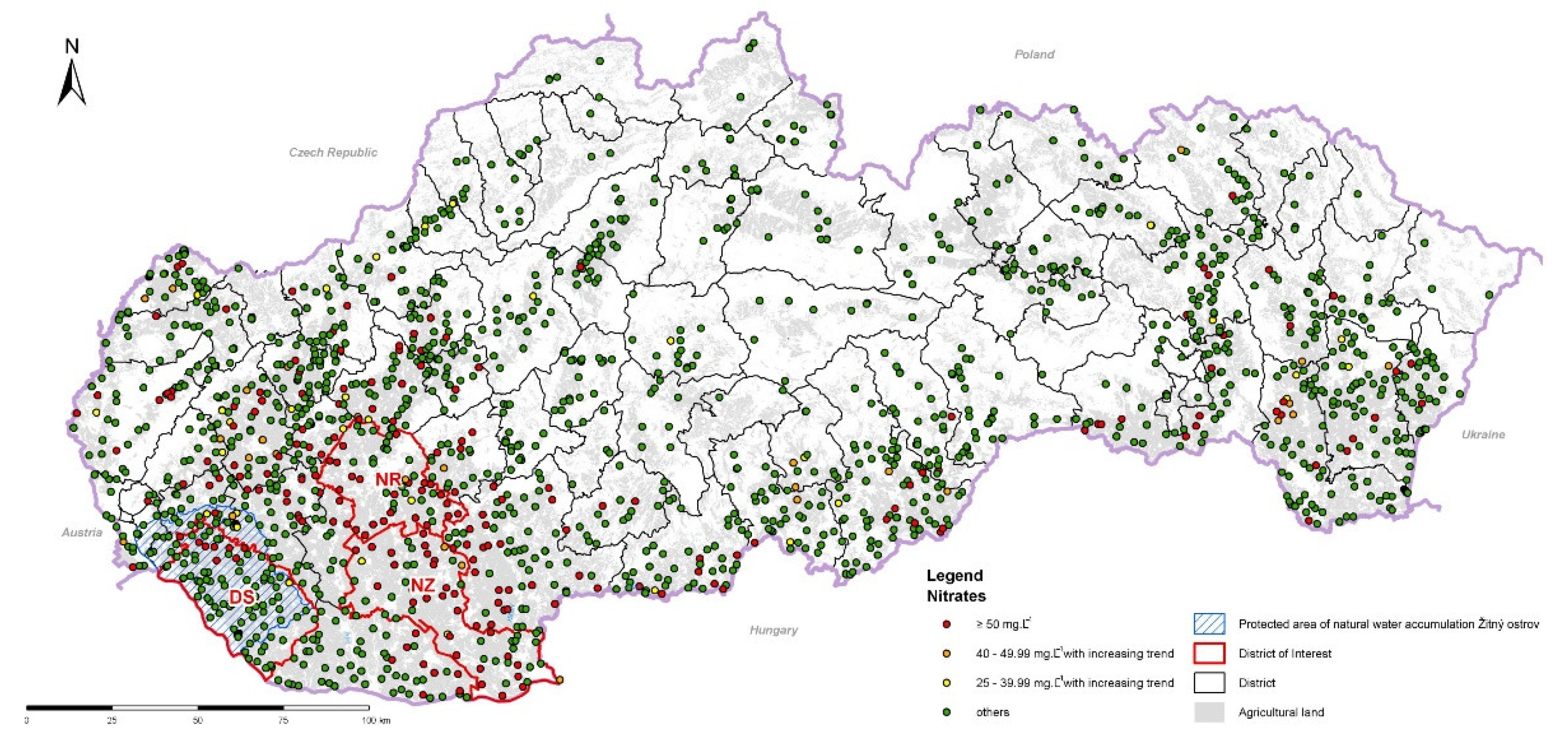

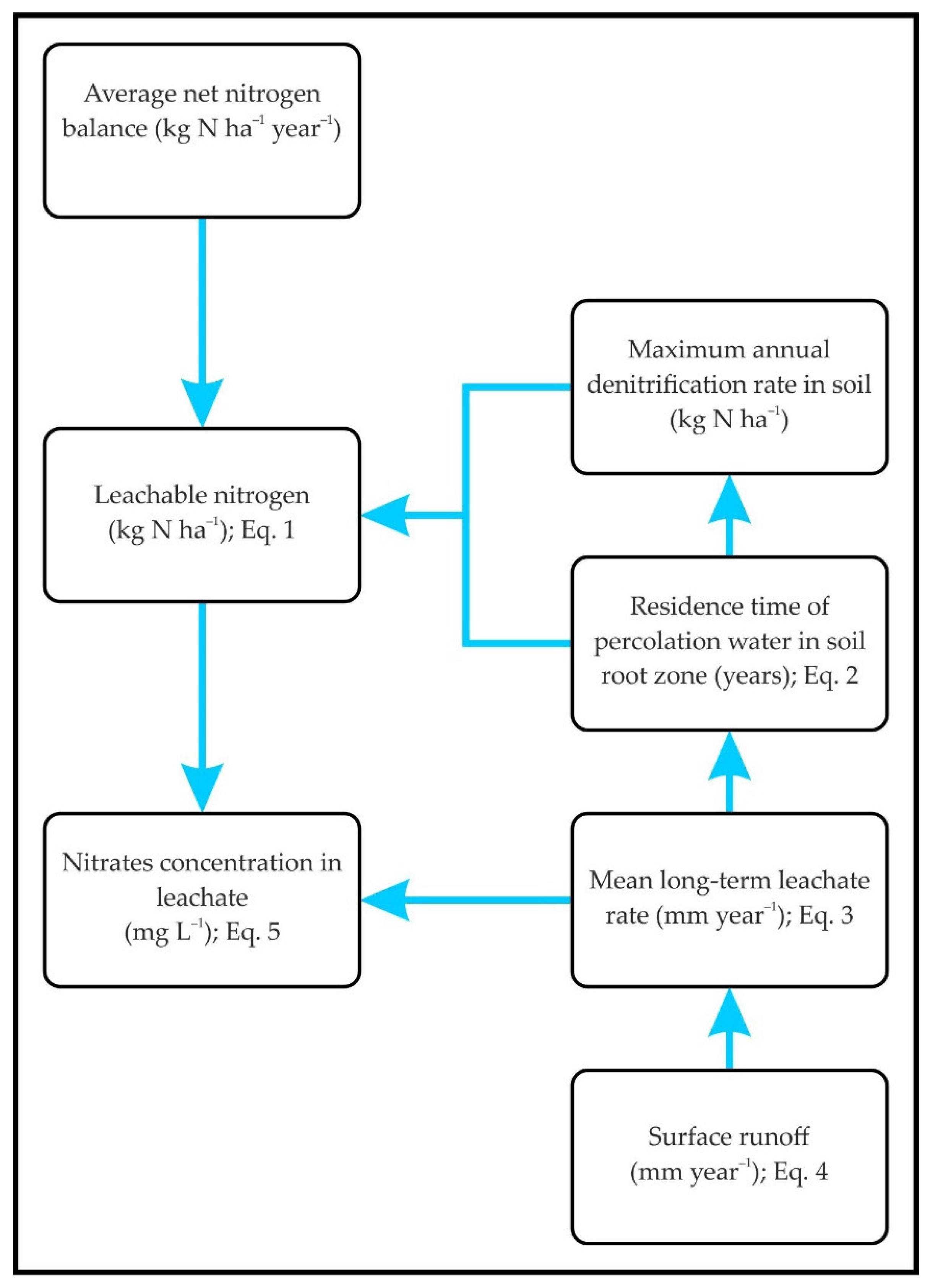
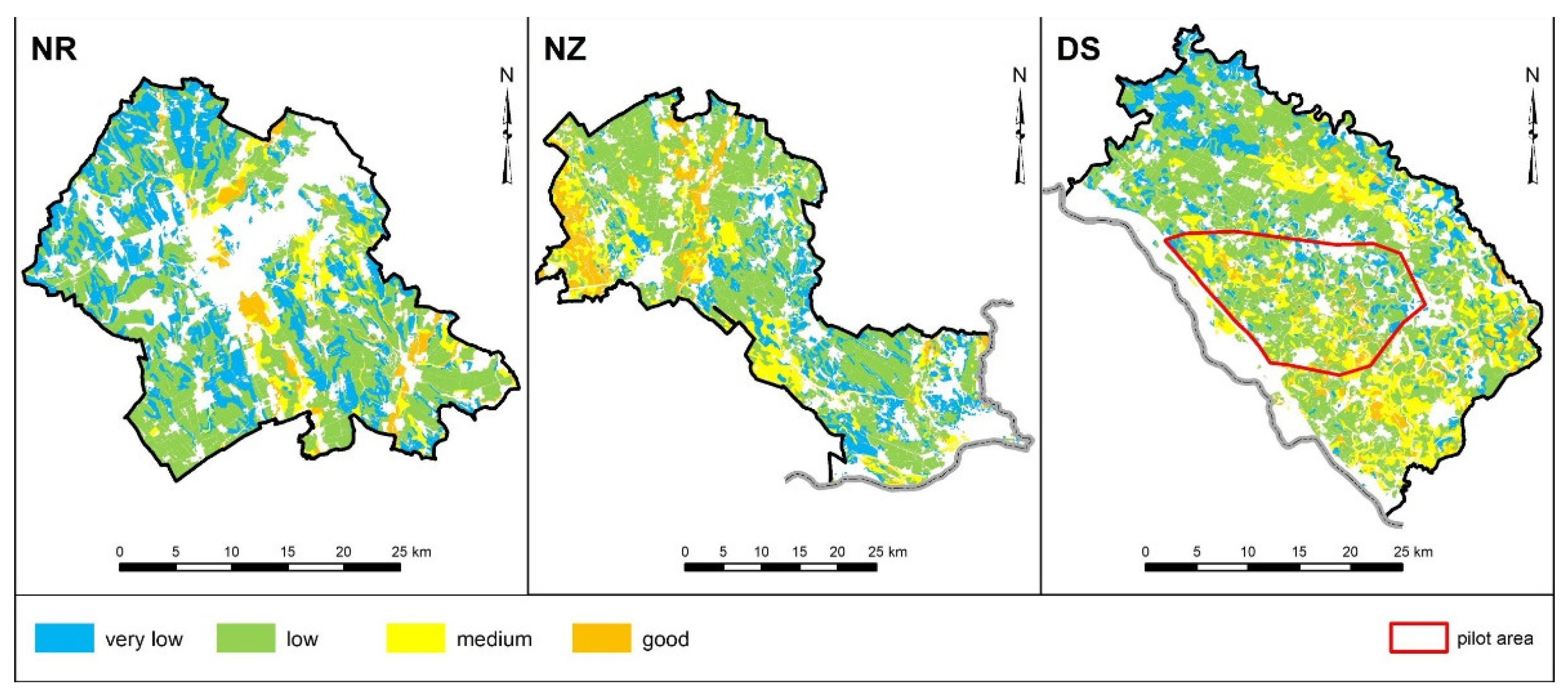

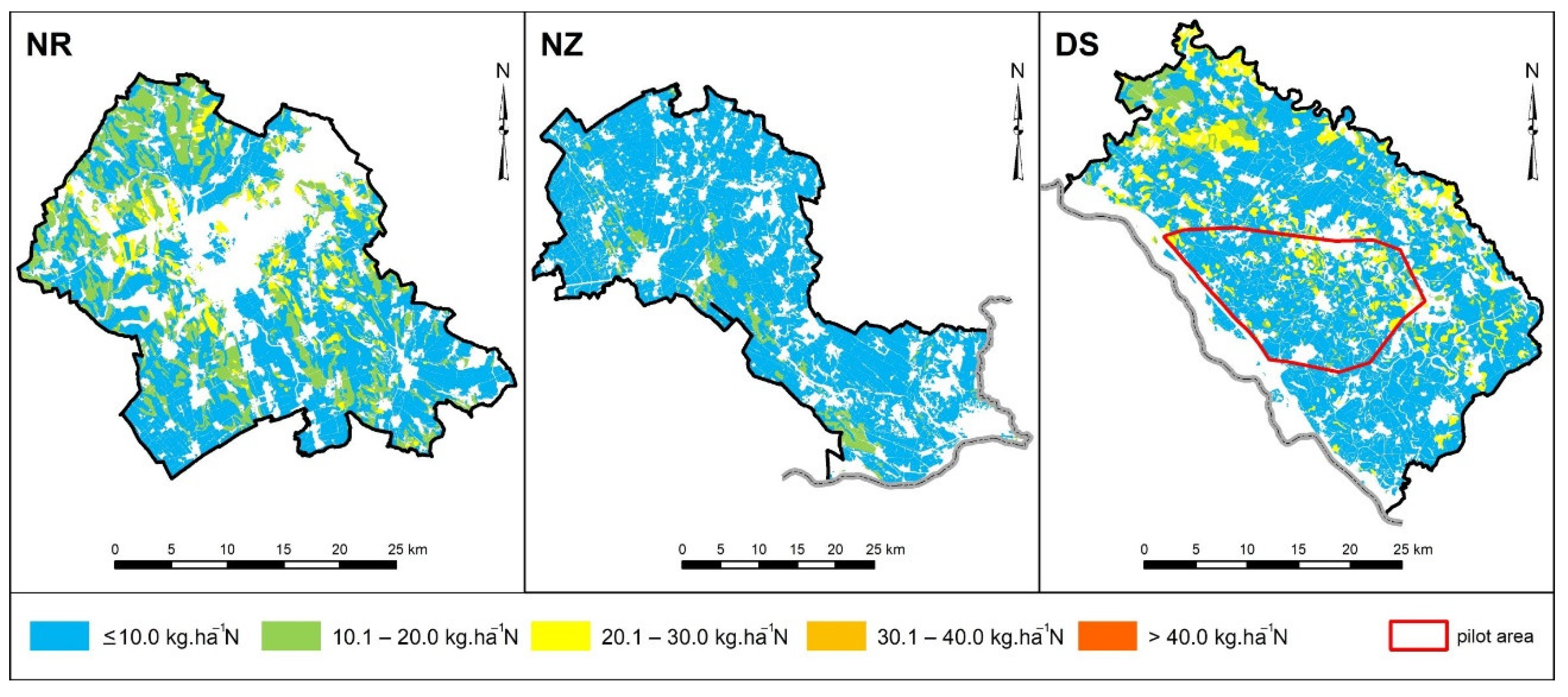
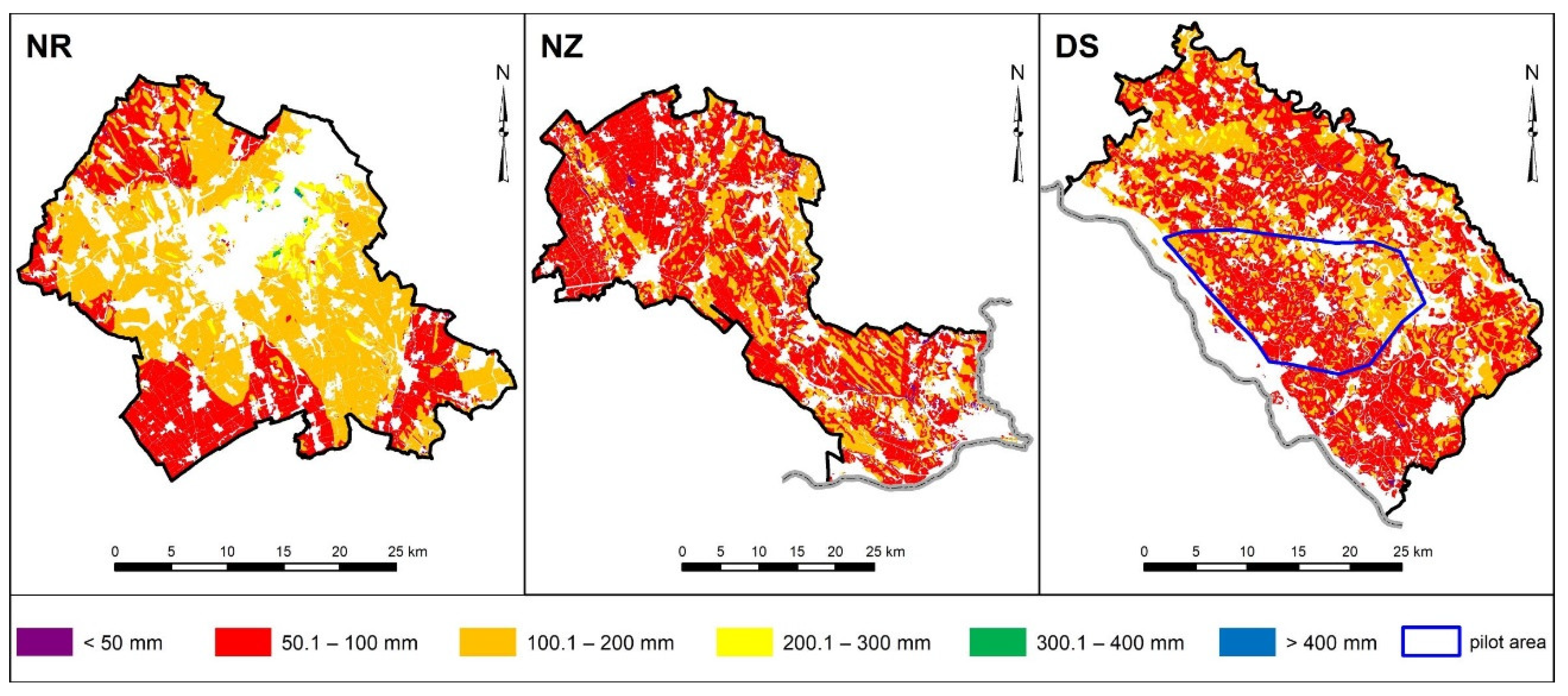

| District/Area | Relative Share of GW Monitoring Sites (%) | ||
|---|---|---|---|
| 25–39.99 (mg L−1) | 40–49.99 (mg L−1) | 50 and More (mg L−1) | |
| (Increasing Trend) | (Increasing Trend) | ||
| Nitra | 0.0 | 2.2 | 50.0 |
| Nové Zámky | 0.0 | 6.6 | 42.6 |
| Dunajská Streda | 0.8 | 0.8 | 8.2 |
| Pilot area | 0.0 | 0.0 | 0.0 |
| District/Area | Utilized | Relative Share (%) | ||
|---|---|---|---|---|
| Agricultural | Arable Land | Permanent | Permanent | |
| Land | and Kitchen | Cultures | Grasslands | |
| (Thou. ha) | Gardens | |||
| Nitra | 60.32 | 97.62 | 1.72 | 0.66 |
| Nové Zámky | 107.90 | 97.06 | 1.81 | 1.13 |
| Dunajská Streda | 75.04 | 98.58 | 0.72 | 0.70 |
| Pilot area | 16.69 | 98.70 | 0.32 | 0.98 |
| Soil Type | District/Area | |||
|---|---|---|---|---|
| Nitra | Nové | Dunajská | Pilot Area | |
| Zámky | Streda | |||
| Regosol | 27.33 | 10.13 | 0.03 | 0.05 |
| Fluvisol | 2.60 | 1.85 | 16.64 | 5.18 |
| Gleyic Fluvisol | 3.77 | 1.81 | 1.07 | 0.11 |
| Fluvic Gleyic Chernozem | 4.73 | 13.87 | 20.30 | 25.58 |
| Chernic Gleysol | 1.50 | 6.49 | 6.49 | 5.88 |
| Rendzic Skeletic Leptosol | 0.10 | 0.05 | ||
| Lithic Leptosol | 0.01 | |||
| Haplic Chernozem | 6.13 | 26.52 | 53.96 | 59.70 |
| Luvic Phaeozem | 20.65 | 30.24 | ||
| Haplic Luvisol | 22.20 | 6.90 | ||
| Albic Luvisol | 2.61 | 0.69 | ||
| Stagnic Luvisol | 6.35 | 0.79 | ||
| Albi Stagnic Fragic Luvisol | 0.99 | 0.01 | ||
| Haplic Cambisol | 0.67 | 0.06 | ||
| Stagnic Cambisol | 0.11 | |||
| Fragic Planosol | 0.07 | 0.02 | ||
| Gleysol | 0.09 | 0.02 | ||
| Histosol | 0.11 | 1.40 | 3.51 | |
| Haplic Solonchak | 0.02 | 0.36 | ||
| Anthrosol | 0.05 | 0.09 | 0.12 | |
| District/Area | Gross Balance | Net Balance |
|---|---|---|
| Nitra | 43.2 | 25.5 |
| Nové Zámky | 28.3 | 13.6 |
| Dunajská Streda | 44.2 | 23.5 |
| Pilot area | 44.7 | 21.5 |
| District | Nitrates Concentration (mg L−1) | |||
|---|---|---|---|---|
| Percolation | Groundwater | |||
| Water | 25–39.99 | 40–49.99 | ≥50 | |
| Nitra | <25 | 1 | 1 | 14 |
| 25–39.99 | - | - | 1 | |
| 40–49.99 | - | - | - | |
| ≥50 | - | - | 8 | |
| Nové Zámky | <25 | 2 | 3 | 24 |
| 25–39.99 | - | 1 | 2 | |
| 40–49.99 | - | - | - | |
| ≥50 | - | - | - | |
| Dunajská Streda | <25 | - | 1 | 8 |
| 25–39.99 | - | - | - | |
| 40–49.99 | - | - | 1 | |
| ≥50 | 1 | - | 1 | |
| District/Area | N Surplus | UAL Acreage |
|---|---|---|
| (kg ha−1) | (ha) | |
| Nitra | 0.1–5.0 | 1148 |
| 5.1–10.0 | 17,234 | |
| 10.1–15.0 | 251 | |
| Nové Zámky | 0.1–5.0 | 4 |
| 5.1–10.0 | 0 | |
| 10.1–15.0 | 0 | |
| Dunajská Streda | 0.1–5.0 | 2587 |
| 5.1–10.0 | 10,387 | |
| 10.1–15.0 | 0 | |
| Pilot area | 0.1–5.0 | 1389 |
| 5.1–10.0 | 737 | |
| 10.1–15.0 |
Publisher’s Note: MDPI stays neutral with regard to jurisdictional claims in published maps and institutional affiliations. |
© 2022 by the authors. Licensee MDPI, Basel, Switzerland. This article is an open access article distributed under the terms and conditions of the Creative Commons Attribution (CC BY) license (https://creativecommons.org/licenses/by/4.0/).
Share and Cite
Bujnovský, R.; Koco, Š.; Cibulka, R.; Vranovská, A.; Vrablíková, D. Nitrate Concentration in Leachate—Essential Information for Reducing Nitrogen Surplus and Groundwater Pollution from Agricultural Land in Slovakia. Agriculture 2022, 12, 493. https://doi.org/10.3390/agriculture12040493
Bujnovský R, Koco Š, Cibulka R, Vranovská A, Vrablíková D. Nitrate Concentration in Leachate—Essential Information for Reducing Nitrogen Surplus and Groundwater Pollution from Agricultural Land in Slovakia. Agriculture. 2022; 12(4):493. https://doi.org/10.3390/agriculture12040493
Chicago/Turabian StyleBujnovský, Radoslav, Štefan Koco, Roman Cibulka, Andrea Vranovská, and Dana Vrablíková. 2022. "Nitrate Concentration in Leachate—Essential Information for Reducing Nitrogen Surplus and Groundwater Pollution from Agricultural Land in Slovakia" Agriculture 12, no. 4: 493. https://doi.org/10.3390/agriculture12040493
APA StyleBujnovský, R., Koco, Š., Cibulka, R., Vranovská, A., & Vrablíková, D. (2022). Nitrate Concentration in Leachate—Essential Information for Reducing Nitrogen Surplus and Groundwater Pollution from Agricultural Land in Slovakia. Agriculture, 12(4), 493. https://doi.org/10.3390/agriculture12040493






